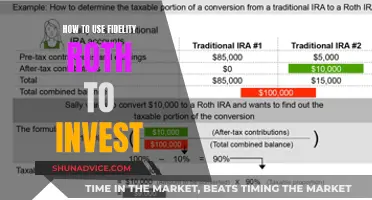
Before investing, it's important to set clear goals and determine how much you can afford to invest, your risk tolerance, and your investing style.
Setting clear investment goals will help guide your investment decisions and keep you focused. You should also evaluate your finances and be realistic about how much you can put toward your investment goals, considering your savings, regular income, and any other financial resources.
It's crucial to understand your risk tolerance, which will help you align your comfort level with the uncertainties of the stock market and your financial goals. Your risk tolerance depends on your investment timeline, with longer horizons allowing for more risk since there is time to recover from potential losses.
Additionally, you should choose an investment account that matches your trading style and goals. There are different types of accounts, such as regular brokerage accounts, retirement accounts, and managed accounts, each with its own features, benefits, and drawbacks.
Finally, it's essential to research and analyze the companies you are considering investing in. Understand their business, performance, and financial health to make informed decisions.
| Characteristics | Values |
|---|---|
| Investment goals | Clear, specific, realistic, ranked |
| Investment amount | Varies depending on income, savings, debts, and expenses |
| Risk tolerance | Depends on age, time horizon, and financial cushion |
| Investment style | DIY (active or passive) or professional guidance |
| Investment account | Brokerage account, retirement account, or managed account |
| Investment research | Company information, P/E ratio, beta, dividend, and charts |
What You'll Learn

Evaluate your financial situation
Evaluating your financial situation is a crucial step in determining if and how you should invest. Here are some detailed instructions and considerations to help you assess your financial situation effectively:
Understand your income and expenses:
Start by taking a close look at your monthly income. Consider your salary, investments, and any other sources of income. Then, evaluate your essential expenses, such as rent, utilities, groceries, and other necessary costs. Understanding your income and essential expenses will help you determine how much money you have available for investing.
Assess your debt and savings:
Evaluate your debt obligations, especially high-interest debt like credit cards. Create a plan to manage and reduce your debt over time. Additionally, assess your savings and emergency funds. It's generally recommended to have three to six months' worth of essential expenses saved in an emergency fund before investing a significant portion of your income.
Set clear financial goals:
Define your short-term and long-term financial goals. For example, you may be saving for a down payment on a house, planning for retirement, or aiming to fund your child's education. Prioritize these goals based on their importance and urgency. Understanding your goals will help guide your investment strategy.
Determine your risk tolerance:
Consider how comfortable you are with taking on risk. Investing always carries some level of risk, and different investment options have varying levels of risk and potential reward. Assess your willingness to accept higher risks for potentially greater returns or your preference for stability and lower risk. Your risk tolerance will influence the types of investments you choose.
Evaluate your investment timeline:
Consider your investment horizon, or how long you plan to invest before needing to access your funds. Longer investment timelines often allow for more aggressive investment strategies, as you have more time to recover from potential losses. Shorter timelines typically require a more conservative approach to minimize risk.
Consult a financial professional:
If you feel overwhelmed or unsure about evaluating your financial situation, consider seeking advice from a fiduciary financial advisor. They can provide personalized guidance based on your unique circumstances and help you make informed decisions about investing.
Understanding Cash Investments in Your Portfolio
You may want to see also

Determine your risk tolerance
Understanding your risk tolerance is a cornerstone of investing. It helps you align your comfort level with the uncertainties of the stock market and your financial goals. Here are some tips for assessing your risk tolerance:
- Self-assessment: Reflect on your comfort level with the ups and downs of the stock market. Are you willing to accept higher risks for potentially greater returns, or do you prefer stability even if that means potentially less in the end?
- Consider your time horizon: Your risk tolerance depends on your investment timeline. Longer horizons allow for more risk since you have time to recover from potential losses. Shorter timelines require more conservative investments.
- Gauge your financial cushion: Assess your finances, including your savings, emergency fund, and other investments. A solid financial cushion can help you take on more risk.
- Adjust over time: Your risk tolerance may change as your finances and goals evolve, so regularly reassess and adjust your investment strategy accordingly.
- Evaluate your comfort zone in taking on risk: All investments involve some degree of risk. It's important to understand that you could lose some or all of your money. The reward for taking on risk is the potential for a greater investment return.
- Determine your investing approach: Some investors choose to buy individual stocks, while others take a less active approach. Consider whether you enjoy crunching numbers and doing research, or if you prefer a more passive approach.
- Decide how much to invest: Assess the money you shouldn't invest in stocks. The stock market is no place for money that you might need within the next five years. While the stock market will almost certainly rise over the long run, there's too much uncertainty in stock prices in the short term.
Choosing the right asset classes
Once you understand your risk tolerance, you can choose the types of investments that match it. Here are some tips for choosing the right asset classes:
- Asset allocation: Put your investment capital into several types of investments, each representing a percentage of the whole. Allocating assets into different classes that are not highly correlated in their price action can effectively diversify risk.
- Choose lower-risk options: If temporary losses keep you awake at night, concentrate on lower-risk options like bonds.
- Take on more risk: If you can weather setbacks in pursuit of aggressive long-term growth, go for stocks.
- Diversify your portfolio: Choose among various asset classes to manage risk and earn greater rewards. Include a combination of stocks, bonds, and cash, as well as other alternative assets such as real estate, foreign currency, and commodities.
Other considerations
- Your age: As you get older, stocks gradually become a less desirable place to keep your money. If you're young, you have decades ahead of you to ride out any ups and downs in the market.
- Your goals: Are you investing for retirement, or do you have a shorter-term goal like purchasing a home or retiring early? Your timeline and goals will impact your risk tolerance and investment strategy.
- Your debt: Debt, especially high-interest debt, can become difficult to manage if you don't have a plan to pay off the balances. Consider how much you can comfortably afford to invest while still making at least the minimum payments on your debts.
- Your emergency savings: Having an emergency fund is crucial if you want to avoid taking on debt when unexpected expenses arise. Consider investing a smaller amount of your available income while working towards building up your emergency savings.
Investment Bankers: Key Facilitators in the Acquisition Process
You may want to see also

Choose your investment style
There are two main approaches to investing: the DIY route or seeking professional guidance. Each has its pros and cons, and your choice will depend on your level of interest, knowledge, and the time you have available.
DIY investing
If you understand how stocks work and are confident in your ability to make trades, you can manage your investments yourself. There are two ways to do this:
- Active investing: You use your brokerage account to access and trade various investments, including stocks, bonds, and other assets. You set your goals and decide when to buy and sell.
- Passive investing: You use your brokerage account to buy shares in index ETFs and mutual funds. You control which funds you buy, but the fund managers handle the trading for you.
Professional guidance
If you prefer a more personalised approach, an experienced broker or financial advisor can offer tailored advice based on your life experiences and goals. They can help you decide among the most promising stock choices, monitor your portfolio, and collaborate with you when changes are needed.
Other options
Another option is to use a robo-advisor, a brokerage that invests your money on your behalf in a portfolio of index funds appropriate for your age, risk tolerance, and goals. Robo-advisors can also optimise your tax efficiency and make automatic changes over time.
Alternatively, you can use a combination of these approaches. For example, you might use a robo-advisor for a set-and-forget investment strategy while also working with a financial advisor for a more personalised approach.
Key considerations
When choosing your investment style, consider the following:
- Time commitment: Do you have the time to research and analyse stocks, or do you prefer a more hands-off approach?
- Knowledge and interest: Are you interested in learning about how stocks work and analysing different investments, or does this sound like a chore?
- Risk tolerance: Are you comfortable with taking on more risk for potentially greater returns, or do you prefer a more stable, lower-risk approach?
- Investment goals: Are you investing for the long term, such as retirement, or do you have shorter-term goals? Your timeline will impact the level of risk you can take.
- Costs: Different investment approaches have varying costs. For example, full-service brokers typically charge higher fees, while discount brokers offer lower fees or no commissions per trade.
Final thoughts
Remember, your investment style doesn't have to be set in stone. You can start with one approach and adjust as you gain more knowledge and experience. The most important thing is to get started and make any necessary changes along the way.
Warren Buffet's Berkshire Cash Reserves: Where Does it Go?
You may want to see also

Pick your stocks
Picking your stocks is a nuanced process that can take a lifetime to master. Here are some key considerations to help you get started:
Determine Your Risk Tolerance
Understanding your risk tolerance is crucial before investing in stocks. All investments carry some level of risk, and it's important to recognise that you could lose some or all of your money. Evaluate your comfort level with risk and choose investments that align with it. If you're more risk-averse, consider lower-risk options like bonds. If you're comfortable with higher risk for potentially higher returns, stocks may be a better option.
Diversify Your Portfolio
Diversification is a key concept in investing. By allocating your investment capital across multiple asset classes, such as stocks, bonds, real estate, and commodities, you can reduce risk and potentially increase your returns. Diversification ensures that all your eggs are not in one basket, so a poor performance in one area doesn't sink your entire investment strategy.
Understand Stock-Picking Strategies
There are several key factors to consider when evaluating individual stocks:
- Dividends: Dividends are payments made by companies to their shareholders. Established companies often pay dividends, and they can significantly boost your earnings over time.
- Price-to-Earnings (P/E) Ratio: This metric compares a company's current share price to its earnings per share. A high P/E ratio indicates that investors have high expectations, while a low P/E ratio may suggest a company is undervalued.
- Beta: Beta measures a stock's volatility in comparison to the overall market. A beta of 1 means a stock's volatility matches the market, while a beta above or below 1 indicates higher or lower volatility, respectively.
- Earnings Per Share (EPS): EPS represents the portion of a company's earnings allocated to each share of common stock. A higher EPS typically leads to higher share prices.
- Historical Returns: While past performance doesn't guarantee future results, analysing a stock's historical returns can provide context for its potential future performance.
Commit to a Timeline
Investing is typically a long-term endeavour. Give your investments time to grow and compound. Short-term gains are possible but less likely.
Keep Costs Low
Brokerage fees and mutual fund expense ratios can eat into your returns. Shop around for low-cost options to maximise your investment's growth potential.
Maximizing Your HSA: Smart Investing for Beginners
You may want to see also

Monitor your investments
Monitoring your investments is an important part of investing. Here are some tips to help you monitor your investments effectively:
- Stay informed about the global economy, industry trends, and the companies you are invested in. Reputable financial news sites are a good source of information.
- Review your investment goals regularly and adjust them as necessary. Life circumstances change, and your investment goals should reflect those changes.
- Re-evaluate your risk tolerance over time. As your finances and goals evolve, your risk tolerance may change, and you should adjust your investment strategy accordingly.
- Diversify your investments across different asset classes to reduce risk and improve the potential for returns. This can include investing in stocks, bonds, real estate, commodities, and more.
- Consider using a combination of stocks and bonds in your portfolio. Historically, the returns of these two asset classes have not moved in the same direction, so including both can help protect against significant losses.
- Monitor the performance of your investments and make changes as needed. This may involve buying more of an investment when its price is low and selling when it is high.
- Review your portfolio on a regular basis, such as every six or twelve months, to ensure it aligns with your investment goals and risk tolerance.
- Seek advice from financial professionals or use robo-advisors to get personalized recommendations and stay informed about market trends.
- Take advantage of educational resources and investment simulators to improve your investment knowledge and practice trading without risk.
Extra Cash: Where to Invest for Maximum Returns
You may want to see also
Frequently asked questions
This depends on your financial situation and goals. Some experts recommend investing at least 15% of your income, while others suggest a set dollar amount that you consistently invest. It's important to consider your income, debt balances, emergency savings, and investment goals when deciding how much to invest.
Diversifying your portfolio by investing in different asset classes, such as stocks, bonds, real estate, and commodities, can help manage risk and increase rewards. When choosing specific investments, consider factors such as the company's performance, industry, and risk tolerance.
All investments carry some level of risk. To manage risk, it's important to understand your risk tolerance and create a financial plan that aligns with your goals. Diversification, dollar-cost averaging, and investing for the long-term can also help mitigate risk.
The first step is to set clear investment goals and determine how much you can afford to invest. Then, you need to choose an investment account and a broker that aligns with your goals and risk tolerance. Finally, you can fund your account and start investing by purchasing stocks or other investments.







